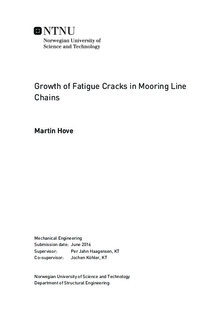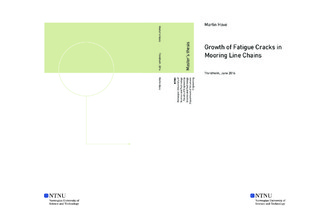| dc.description.abstract | This master thesis is the continuation of a project work conducted during the fall of 2015, and is part of a series of studies investigating the effect of surface condition on the fatigue life of mooring chains. The study focuses on the use of fracture mechanics to predict the fatigue life of a mooring chain with a corrosion pit. In order to do this, a fatigue model was proposed which is divided into a local and a global model. The local model considers the surface of the chain link by modelling a 20mm segment of the surface at the crown of the chain link as a plate with a corrosion pit. The pit was idealized as a hemispherical notch of radius 1mm. The finite element method was used to model cracks initiating at different locations in the corrosion pit.
Three hypotheses were suggested for the crack initiation and growth. The first hypothesis assumes that the crack starts in the bottom of the pit, and grows with a circular crack front, until it encompasses the whole pit. After the pit is encompassed, it continues growing first as a circular crack and then the crack front changes into an elliptic shape. The second hypothesis assumes that the crack starts on the surface of the plate, in the side of the notch, and that the crack continues growing until it reaches the same depth as the corrosion pit. It will then grow into an elliptic crack of crack ratio 0.5, encompassing the pit, with origin at the original crack origin. The third hypothesis assumes that the crack initially encompasses the pit, and grows as a circular crack until the crack front changes shape into an elliptical front.
The first part of the crack growth is modelled in the local model. This was done by writing a python script for ABAQUS, which would calculate the stress intensity factor of the crack, and then move the crack front incrementally and remesh the model as the crack progressed. The results from the local model showed the expected trend, as the first and third hypotheses converged towards the handbook solution for a plate with a circular crack, while the second hypotheses converged towards the solution for a plate with an elliptical crack of ratio 0.5. It was found that the stress intensity factor for the crack originating in the side of the pit was higher than for the cracks emitting in the bottom and encompassing the pit for both tension and bending. The Kondo criteria was used to argue for the cracks being more likely to initiate in the side of the pit.
The stable crack growth was modelled in the global model, also by the use of a python script to incrementally move the crack. Three models were created. The first had a crack with a constant circular crack front shape. The second started with an initial crack ratio of 0.5 which was changed as the crack progressed. The same was done for the third model, but with an initial crack ratio of 1.0. The stress intensity factors for the global model showed good consistency with handbook solutions.
The transition region was not modelled, and it was estimated by curve fitting the results between the local and the global model. This worked well for the first and third hypotheses. There was a discrepancy between the local and global solution for the second hypothesis, as the elliptical crack is more severe in a rod, than an equivalent crack in a plate. This caused the solutions to not align well. The discrepancy was solved by ignoring all analysis results from the local model which showed lower values for the stress intensity factor than the global model.
A MATLAB script was used to integrate Paris' law to find life estimates for the chain links for the different hypotheses. It was found that between 18 to 53% of the life of the chain link was spent in the local and transition phase, defined as a a crack depth between 0.2 to 5mm. The initial crack depth and loads were varied in order to generate a set of SN data. The data set showed a good consistency with the DNV GL SN curve for studless chain links.
Two simplified methods to calculate the stress intensity factor for a crack in the crown of the chain were reviewed. They showed non-conservative results with an error of about 10% in the early growth phase. Due to these attributes, they are not recommended for further use.
It is recommended to perform more studies on the effect of different pit geometries. More research should also be done in order to find how the crack front shape develops from cracks originating at different locations in the pit. | |

